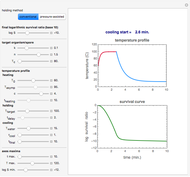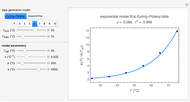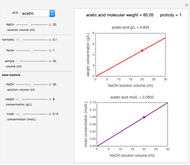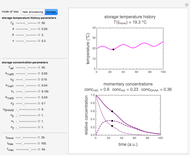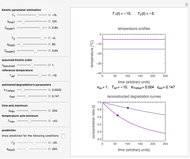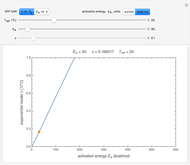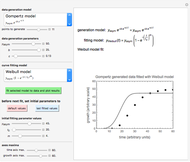Brix Corrections for Citric Acid and Temperature

Requires a Wolfram Notebook System
Interact on desktop, mobile and cloud with the free Wolfram Player or other Wolfram Language products.
The total soluble solids (TSS) contents of fruit juices and other food products is conveniently determined by a refractometer and expressed in °Brix ( ), which stands for the percent weight of a sucrose solution having the same refractive index at 20 °C. Since citrus juices have a considerable amount of citric acid and the 20 °C temperature is not always maintained, the refractometer's reading needs to be corrected for acidity and temperature following standard tables. This Demonstration calculates the correction for either or both, with the formulas used to create these tables.
), which stands for the percent weight of a sucrose solution having the same refractive index at 20 °C. Since citrus juices have a considerable amount of citric acid and the 20 °C temperature is not always maintained, the refractometer's reading needs to be corrected for acidity and temperature following standard tables. This Demonstration calculates the correction for either or both, with the formulas used to create these tables.
Contributed by: Mark D. Normand and Micha Peleg (April 2014)
Open content licensed under CC BY-NC-SA
Snapshots
Details
Snapshot 1: correction for % citric acid in orange juice
Snapshot 2: correction for temperature in orange juice concentrate
Snapshot 3: correction for citric acid and temperature in orange juice concentrate
°Brix (or  ) stands for the total soluble solids (TSS) of a fruit juice or other food determined by a refractometer at 20 °C and expressed as % sucrose. Since the presence of citric or other acids affects the index of refraction as well as the temperature, the measured
) stands for the total soluble solids (TSS) of a fruit juice or other food determined by a refractometer at 20 °C and expressed as % sucrose. Since the presence of citric or other acids affects the index of refraction as well as the temperature, the measured  ought to be corrected for the acidity and the temperature deviation from 20 °C.
ought to be corrected for the acidity and the temperature deviation from 20 °C.
The acid correction factor  used in this Demonstration is calculated by a slightly modified version of the formula found in [1]: if
used in this Demonstration is calculated by a slightly modified version of the formula found in [1]: if  ,
,  , otherwise
, otherwise  . The temperature correction factor
. The temperature correction factor  is calculated by another formula in [1],
is calculated by another formula in [1],  ,
where the acidity is in % citric acid on a wet basis, and the temperature in °C. For temperatures below 20 °C,
,
where the acidity is in % citric acid on a wet basis, and the temperature in °C. For temperatures below 20 °C,  assumes negative values, and for temperatures above 20 °C, it assumes positive values. The correction factors calculated by these formulas are identical to those in the official tables [1, 2] except for occasional minor discrepancies resulting from rounding.
assumes negative values, and for temperatures above 20 °C, it assumes positive values. The correction factors calculated by these formulas are identical to those in the official tables [1, 2] except for occasional minor discrepancies resulting from rounding.
The Demonstration offers three correction options chosen with setter bars: for acidity only,  ; for temperature only,
; for temperature only,  ; and for the combination of acidity and temperature,
; and for the combination of acidity and temperature,  [1]. For the first two, it calculates and displays the correction factor as a function of the acidity or temperature, and calculates the
[1]. For the first two, it calculates and displays the correction factor as a function of the acidity or temperature, and calculates the  of a chosen
of a chosen  , which can be seen as a red point moved by a slider on the
, which can be seen as a red point moved by a slider on the  versus
versus  plot. For the third option, the correction factor versus the acidity and temperature relationship is shown in a 3D plot where the chosen acidity and temperature combination is marked by a red point. Here too,
plot. For the third option, the correction factor versus the acidity and temperature relationship is shown in a 3D plot where the chosen acidity and temperature combination is marked by a red point. Here too,  is calculated for the chosen
is calculated for the chosen  and its numerical value is displayed.
and its numerical value is displayed.
Since the calculations are done with continuous models, you can select the rounding with the setter bar. Note that the formulas used in this Demonstration for foods very different from citrus juice (or sucrose and citric acid solutions) might not give accurate corrections for the temperature and/or acid effects.
References
[1] Procedures for Analysis of Citrus Products, 6th ed., Lakeland, FL: John Bean Technologies, 2011. www.jbtfoodtech.com/~/media/JBT%20 FoodTech/Files/Citrus/ProceduresManual/Procedures%20 for %20 Analysis %20 of %20 Citrus %20 Products.ashx.
[2] Official Methods of Analysis, 17th ed., Gaithersburg, MD: AOAC International, 2000.
Permanent Citation







